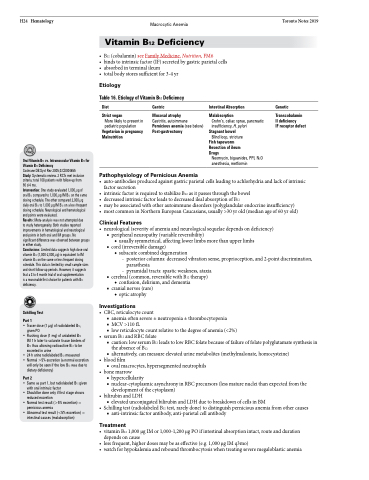Page 564 - TNFlipTest
P. 564
H24 Hematology
Macrocytic Anemia
Toronto Notes 2019
Vitamin B12 Deficiency
• B12 (cobalamin) see Family Medicine, Nutrition, FM6
• bindstointrinsicfactor(IF)secretedbygastricparietalcells • absorbedinterminalileum
• totalbodystoressufficientfor3-4yr
Etiology
Table 16. Etiology of Vitamin B12 Deficiency
Diet
Strict vegan
More likely to present in
pediatric population
Vegetarian in pregnancy Malnutrition
Gastric
Mucosal atrophy
Gastritis, autoimmune Pernicious anemia (see below) Post-gastrectomy
Intestinal Absorption
Malabsorption
Crohn’s, celiac sprue, pancreatic
insufficiency, H. pylori Stagnant bowel
Blind loop, stricture
Fish tapeworm Resection of ileum Drugs
Neomycin, biguanides, PPI, N2O anesthesia, metformin
Genetic
Transcobalamin II deficiency
IF receptor defect
Oral Vitamin B12 vs. Intramuscular Vitamin B12 for Vitamin B12 Deficiency
Cochrane DB Syst Rev 2005;3:CD004655
Study: Systematic review. 2 RCTs met inclusion criteria; total 108 patients with follow-up from
Pathophysiology of Pernicious Anemia
90 d-4 mo.
Intervention: One study evaluated 1,000 μg of
oral B12 compared to 1,000 μg IM B12 on the same dosing schedule. The other compared 2,000 μg daily oral B12 to 1,000 μg IM B12 on a less frequent dosing schedule. Neurological and hematological end points were evaluated.
Results: Meta-analysis was not attempted due
to study heterogeneity. Both studies reported improvements in hematological and neurological end-points in both oral and IM groups. No significant difference was observed between groups in either study.
Conclusions: Limited data suggests high dose oral vitamin B12 (1,000-2,000 μg) is equivalent to IM vitamin B12 on the same or less frequent dosing schedule. This data is limited by small sample sizes and short follow-up periods. However, it suggests that a 3 to 4 month trial of oral supplementation
is a reasonable first choice for patients with B12 deficiency.
Schilling Test
Part 1
• Tracer dose (1 μg) of radiolabeled B12, given PO
• Flushing dose (1 mg) of unlabeled B12 IM 1 h later to saturate tissue binders of B12 thus allowing radioactive B12 to be excreted in urine
• 24 h urine radiolabeled B12 measured
• Normal >5% excretion (a normal excretion
will only be seen if the low B12 was due to dietary deficiency)
Part 2
• Same as part 1, but radiolabeled B12 given with oral intrinsic factor
• Should be done only if first stage shows reduced excretion
• Normal test result (>5% excretion) = pernicious anemia
• Abnormal test result (<5% excretion) = intestinal causes (malabsorption)
• auto-antibodiesproducedagainstgastricparietalcellsleadingtoachlorhydriaandlackofintrinsic factor secretion
• intrinsic factor is required to stabilize B12 as it passes through the bowel
• decreased intrinsic factor leads to decreased ileal absorption of B12
• may be associated with other autoimmune disorders (polyglandular endocrine insufficiency)
• mostcommoninNorthernEuropeanCaucasians,usually>30yrold(medianageof60yrold)
Clinical Features
• neurological(severityofanemiaandneurologicalsequelaedependsondeficiency) ■ peripheral neuropathy (variable reversibility)
◆ usually symmetrical, affecting lower limbs more than upper limbs ■ cord (irreversible damage)
◆ subacute combined degeneration
- posteriorcolumns:decreasedvibrationsense,proprioception,and2-pointdiscrimination,
parasthesia
- pyramidaltracts:spasticweakness,ataxia
■ cerebral (common, reversible with B12 therapy) ◆ confusion, delirium, and dementia
■ cranial nerves (rare) ◆ optic atrophy
Investigations
• CBC,reticulocytecount
■ anemia often severe ± neutropenia ± thrombocytopenia
■ MCV>110fL
■ low reticulocyte count relative to the degree of anemia (<2%)
• serum B12 and RBC folate
■ caution: low serum B12 leads to low RBC folate because of failure of folate polyglutamate synthesis in
the absence of B12
■ alternatively, can measure elevated urine metabolites (methylmalonate, homocysteine)
• bloodfilm
■ oval macrocytes, hypersegmented neutrophils
• bonemarrow
■ hypercellularity
■ nuclear-cytoplasmic asynchrony in RBC precursors (less mature nuclei than expected from the
development of the cytoplasm) • bilirubinandLDH
■ elevated unconjugated bilirubin and LDH due to breakdown of cells in BM
• Schilling test (radiolabeled B12 test, rarely done) to distinguish pernicious anemia from other causes
■ anti-intrinsic factor antibody, anti-parietal cell antibody
Treatment
• vitamin B12 1,000 μg IM or 1,000-1,200 μg PO if intestinal absorption intact, route and duration depends on cause
• lessfrequent,higherdosesmaybeaseffective(e.g.1,000μgIMq3mo)
• watchforhypokalemiaandreboundthrombocytosiswhentreatingseveremegaloblasticanemia


